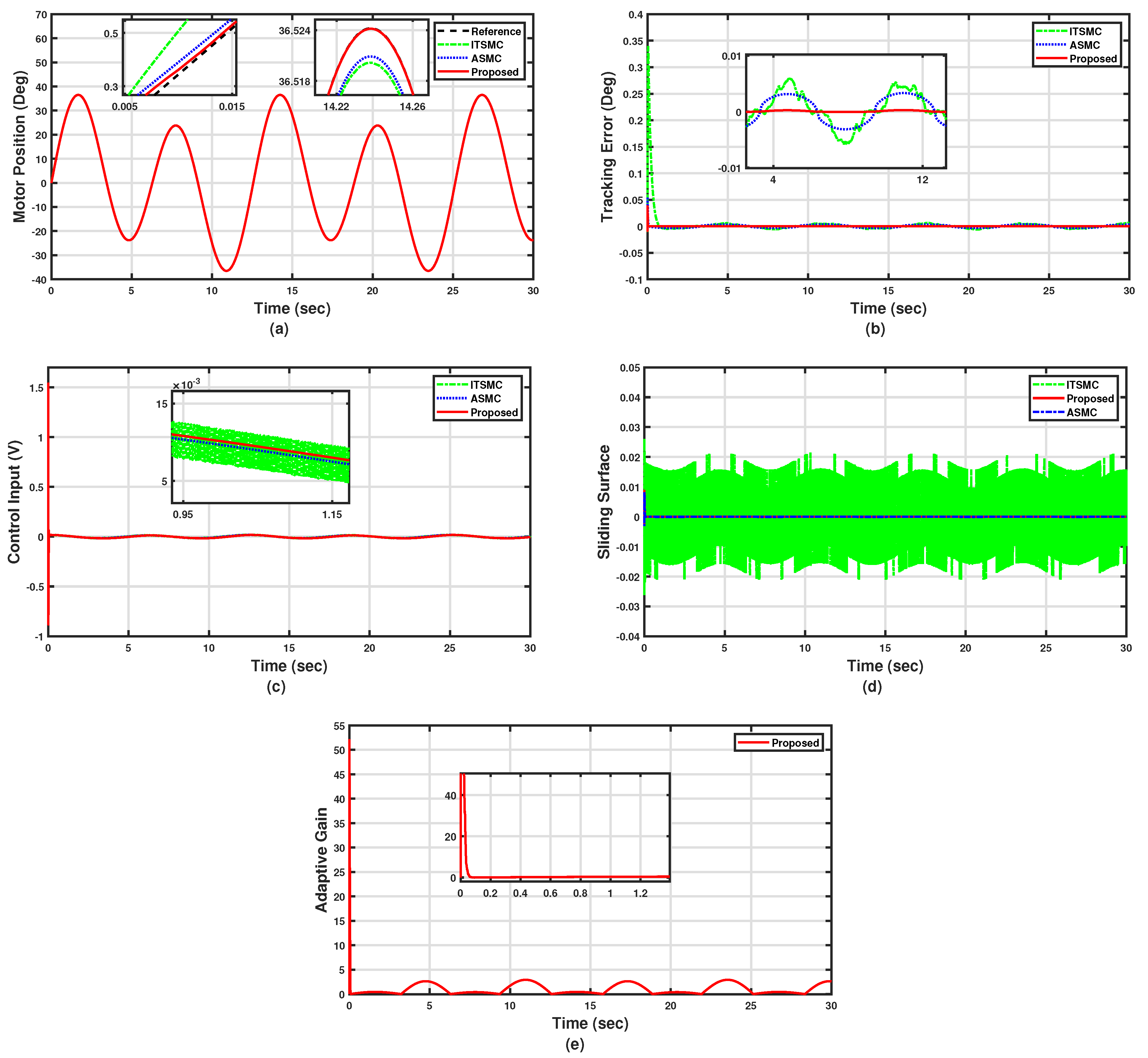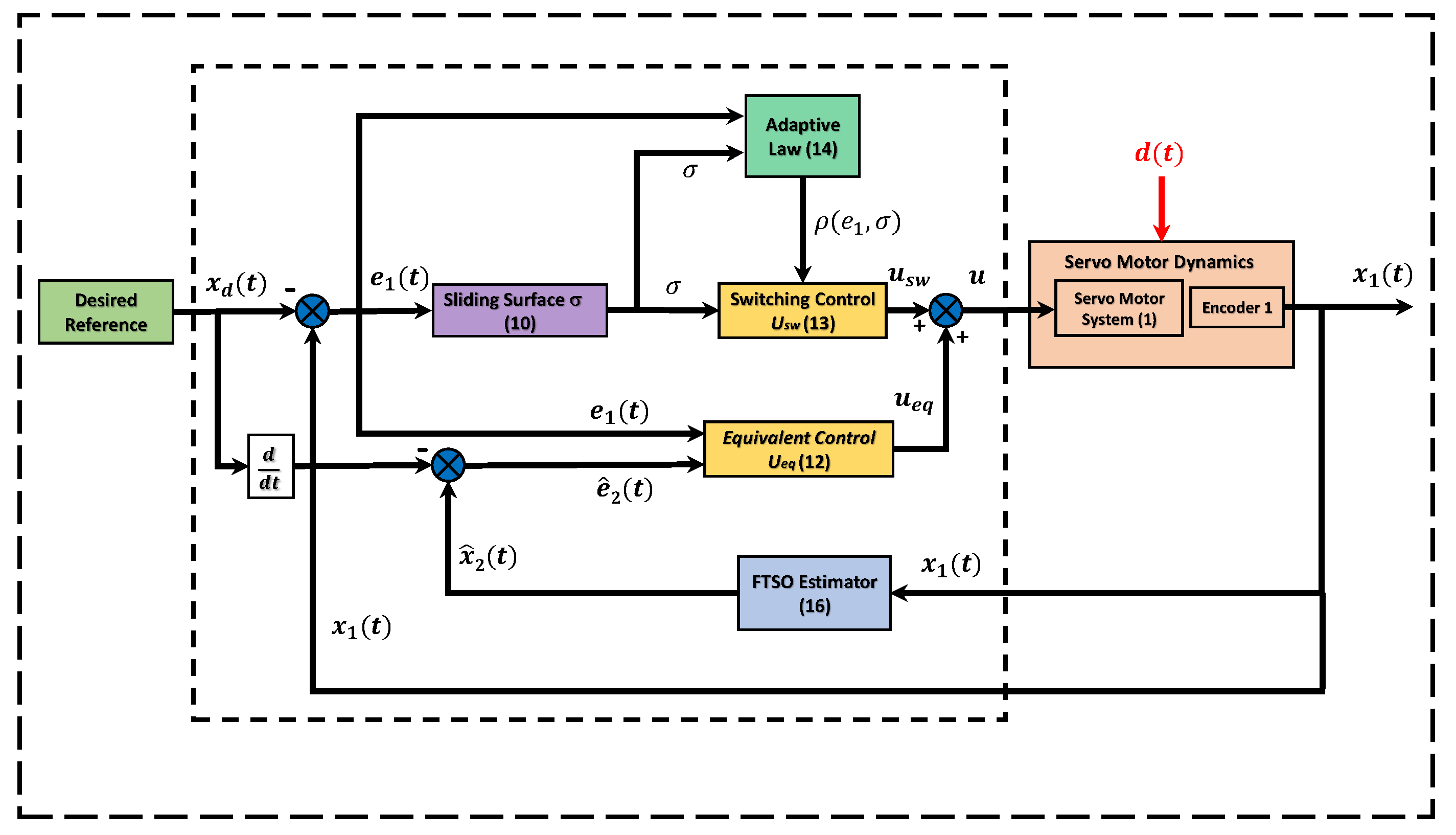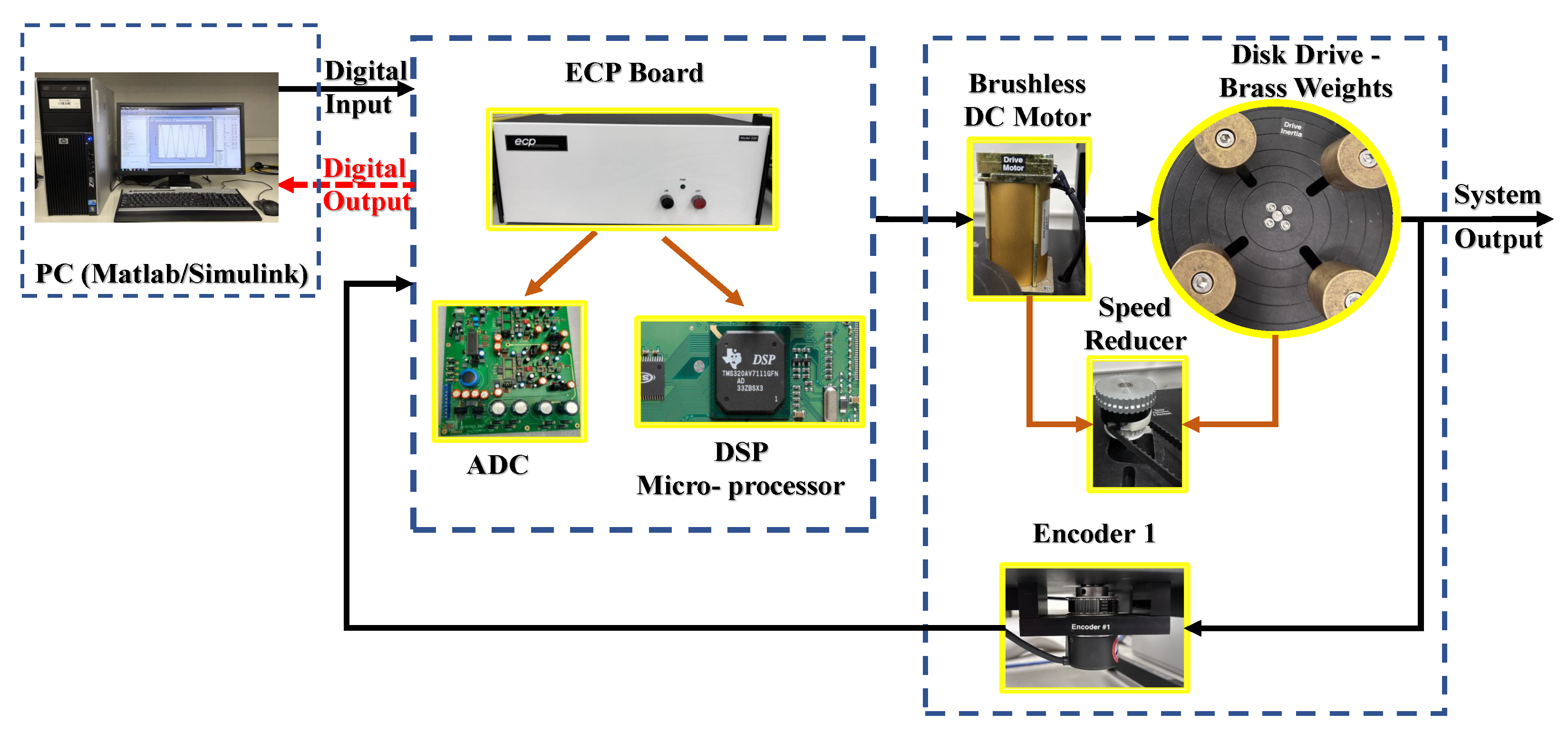Practical Adaptive Fast Terminal Sliding Mode Control for Servo Motors
Abstract
:1. Introduction
- A practical fast terminal sliding mode (PFTSM) surface is modified to ensure not only fast finite time convergence but also chattering reduction in a servo motor.
- A bidirectional adaptive law for switching gain is constructed and used with the proposed control law of the PFTSM to lessen the chattering caused by high constant gain in the conventional TSMC. The switching gain tuned by the proposed adaptive law varies according to uncertainties. This adaptation method provides large gain in the reaching phase when system states are far away from the origin of sliding manifolds and then moves to the smallest values in the sliding phase when states are near to the origin. Moreover, the gain overestimation problem of monotonically adaptive law is being solved by the proposed bidirectional adaptive law.
- By using the Lyapunov theorem, the finite time stability is proved for the whole closed-loop control system under the proposed practical adaptive fast terminal sliding mode control (PAFTSMC) law.
2. Mathematical Modeling of the Servo Motor System
3. Proposed Control Design and Stability Proof
3.1. Design of PAFTSMC Approach
3.2. State Observer Design
3.3. Stability Analysis
4. Simulations and Experimental Results with Discussion
4.1. Simulation Results Analysis


| Cases | Index | Proposed | ITSMC | ASMC |
|---|---|---|---|---|
| Case 1 | RMS () | 0.00045 | 0.0183 | 0.0028 |
| MAX () | 0.0237 | 0.2889 | 0.0653 | |
| Case 2 | RMS () | 0.00056 | 0.0218 | 0.0037 |
| MAX () | 0.0314 | 0.3401 | 0.0753 | |
| Case 3 | RMS () | 0.00048 | 0.0230 | 0.0053 |
| MAX () | 0.0253 | 0.3022 | 0.0703 |

4.2. Experimental Results Analysis
4.2.1. Experimental Setup
4.2.2. Robustness Verification on Brushless DC Servo Motor

| Cases | Index | Proposed | ITSMC | ASMC |
|---|---|---|---|---|
| Case 1 | RMS () | 0.0234 | 0.2179 | 0.1355 |
| MAX () | 0.0461 | 0.3143 | 0.1991 | |
| Case 2 | RMS () | 0.0362 | 0.2915 | 0.1610 |
| MAX () | 0.0459 | 0.4652 | 0.2402 | |
| Case 3 | RMS () | 0.0694 | 0.3396 | 0.1763 |
| MAX () | 0.1967 | 0.5336 | 0.3035 |


5. Conclusions
Author Contributions
Funding
Informed Consent Statement
Data Availability Statement
Conflicts of Interest
References
- Wang, B.; Iwasaki, M.; Yu, J. Command filtered adaptive backstepping control for dual-motor servo systems with torque disturbance and uncertainties. IEEE Trans. Ind. Electron. 2022, 69, 1773–1781. [Google Scholar] [CrossRef]
- Kim, S. Moment of inertia and friction torque coefficient identification in a servo drive system. IEEE Trans. Ind. Electron. 2019, 66, 60–70. [Google Scholar] [CrossRef]
- Zhu, W.L.; Yang, X.; Duan, F.; Zhu, Z.; Ju, B.F. Design and adaptive terminal sliding mode control of a fast tool servo system for diamond machining of freeform surfaces. IEEE Trans. Ind. Electron. 2019, 66, 4912–4922. [Google Scholar] [CrossRef]
- Ding, R.; Ding, C.; Xu, Y.; Liu, W.; Yang, X. Neural network-based robust integral error sign control for servo motor systems with enhanced disturbance rejection performance. ISA Trans. 2022, 129, 580–591. [Google Scholar] [CrossRef]
- Yao, J.; Deng, W. Active disturbance rejection adaptive control of hydraulic servo systems. IEEE Trans. Ind. Electron. 2017, 66, 8023–8032. [Google Scholar] [CrossRef]
- Zhong, G.; Shao, Z.; Deng, H.; Ren, J. Precise position synchronous control for multi-axis servo systems. IEEE Trans. Ind. Electron. 2017, 64, 3707–3717. [Google Scholar] [CrossRef]
- Jasim, M.H. Tuning of a PID controller by bacterial foraging algorithm for position control of DC servo motor. Eng. Technol. J. 2018, 36, 287–294. [Google Scholar] [CrossRef]
- Shi, D.; Xue, J.; Zhao, L.; Wang, J.; Huang, Y. Event-triggered active disturbance rejection control of DC torque motors. IEEE/ASME Trans. Mechatron. 2017, 22, 2277–2287. [Google Scholar] [CrossRef]
- Ding, S.; Mei, K.; Yu, X. Adaptive second-order sliding mode control: A Lyapunov approach. IEEE Trans. Autom. Control 2022, 67, 5392–53997. [Google Scholar] [CrossRef]
- Cheng, Y.; Ren, X.; Zheng, D.; Li, L. Non-linear bandwidth extended-state-observer based non-smooth funnel control for motor-drive servo systems. IEEE Trans. Ind. Electron. 2022, 69, 6215–6224. [Google Scholar] [CrossRef]
- Dong, H.; Yang, X.; Gao, H.; Yu, X. Practical terminal sliding-mode control and its applications in servo systems. IEEE Trans. Ind. Electron. 2023, 70, 752–761. [Google Scholar] [CrossRef]
- Zhang, J.; Gao, W.; Guo, Q. Extended State Observer-Based Sliding Mode Control Design of Two-DOF Lower Limb Exoskeleton. Actuators 2023, 12, 402. [Google Scholar] [CrossRef]
- Ma, Z.; Huang, P.; Kuang, Z. Fuzzy approximate learning-based sliding mode control for deploying tethered space robot. IEEE Trans. Fuzzy Syst. 2021, 29, 2739–2749. [Google Scholar] [CrossRef]
- Chaturvedi, S.; Kachhwaha, M.; Fulwani, D. Robust Integral Sliding Mode Control for Transient Voltage Support from Bi-Directional Converter Based Active Filters in Microgrids. IEEE J. Emerg. Sel. Top. Ind. Electron. 2003, 4, 995–1005. [Google Scholar] [CrossRef]
- Veysi, M.; Aghaei, J.; Soltanpour, M.R.; Shasadeghi, M.; Bahrani, B.; Ryan, D.J. Robust, accurate, and fast decentralized power sharing mechanism for isolated DC microgrid using droop-based sliding-mode control. IEEE Trans. Smart Grid 2022, 13, 4160–4173. [Google Scholar] [CrossRef]
- Feng, Z.; Liang, W.; Ling, J.; Xiao, X.; Tan, K.K.; Lee, T.H. Precision force tracking control of a surgical device interacting with a deformable membrane. IEEE/ASME Trans. Mechatron. 2022, 27, 5327–5338. [Google Scholar] [CrossRef]
- Feng, Z.; Liang, W.; Ling, J.; Xiao, X.; Tan, K.K.; Lee, T.H. Adaptive robust impedance control for an ear surgical device with soft interaction. IEEE/ASME Trans. Mechatron. 2022, 27, 1784–1795. [Google Scholar] [CrossRef]
- Mofid, O.; Mobayen, S. Adaptive sliding mode control for finite-time stability of quad-rotor UAVs with parametric uncertainties. ISA Trans. 2018, 72, 1–14. [Google Scholar] [CrossRef]
- Zhang, B.; Nie, K.; Chen, X.; Mao, Y. Development of sliding mode controller based on internal model controller for higher precision electro-optical tracking system. Actuators 2022, 11, 16. [Google Scholar] [CrossRef]
- Zhihong, M.; Yu, X.H. Terminal sliding mode control of MIMO linear systems. IEEE Trans. Circuits Syst. I Fundam. Theory Appl. 1997, 44, 1065–1070. [Google Scholar] [CrossRef]
- Feng, Y.; Yu, X.; Man, Z. Non-singular terminal sliding mode control of rigid manipulators. Automatica 2002, 38, 2159–2167. [Google Scholar] [CrossRef]
- Ding, S.; Hou, Q.; Wang, H. Disturbance-observer-based second-order sliding mode controller for speed control of PMSM drives. IEEE Trans. Energy Convers. 2023, 38, 100–110. [Google Scholar] [CrossRef]
- Kommuri, S.K.; Rath, J.J.; Veluvolu, K.C. Sliding-mode-based observer–controller structure for fault-resilient control in DC servomotors. IEEE Trans. Ind. Electron. 2018, 65, 918–929. [Google Scholar] [CrossRef]
- Li, J.; Liu, X.; Xu, M.; Fang, Y. Continuous higher-order sliding mode control for a class of n-th order perturbed systems. IEEE Trans. Circuits Syst. II Express Briefs 2022, 69, 3179–3183. [Google Scholar] [CrossRef]
- Fei, J.; Wang, H.; Fang, Y. Novel neural network fractional-order sliding-mode control with application to active power filter. IEEE Trans. Syst. Man Cybern. Syst. 2022, 52, 3508–3518. [Google Scholar] [CrossRef]
- Çelik, D.; Ahmed, H.; Meral, M.E. Kalman filter-based super-twisting sliding mode control of shunt active power filter for electric vehicle charging station applications. IEEE Trans. Power Del. 2023, 38, 1097–1107. [Google Scholar] [CrossRef]
- Junejo, A.K.; Xu, W.; Mu, C.; Ismail, M.M.; Liu, Y. Adaptive speed control of PMSM drive system based a new sliding-mode reaching law. IEEE Trans. Power Electron. 2020, 35, 12110–12121. [Google Scholar] [CrossRef]
- Tian, D.; Xu, R.; Sariyildiz, E.; Gao, H. An adaptive switching-gain sliding-mode-assisted disturbance observer for high-precision servo control. IEEE Trans. Ind. Electron. 2022, 69, 1762–1772. [Google Scholar] [CrossRef]
- Piñón, A.; Favela-Contreras, A.; Beltran-Carbajal, F.; Lozoya, C.; Dieck-Assad, G. Novel Strategy of Adaptive Predictive Control Based on a MIMO-ARX Model. Actuators 2022, 11, 21. [Google Scholar] [CrossRef]
- Armghan, H.; Yang, M.; Ali, N.; Armghan, A.; Alanazi, A. Quick reaching law based global terminal sliding mode control for wind/hydrogen/battery DC microgrid. Appl. Energy 2022, 316, 119050. [Google Scholar] [CrossRef]
- Zheng, J.; Wang, H.; Man, Z.; Jin, J.; Fu, M. Robust motion control of a linear motor positioner using fast nonsingular terminal sliding mode. IEEE/ASME Trans. Mechatron. 2015, 20, 1743–1752. [Google Scholar] [CrossRef]
- Xu, D.; Ding, B.; Jiang, B.; Yang, W.; Shi, P. Nonsingular fast terminal sliding mode control for permanent magnet linear synchronous motor via high-order super-twisting observer. IEEE/ASME Trans. Mechatron. 2022, 27, 1651–1659. [Google Scholar] [CrossRef]
- Feng, Y.; Zhou, M.; Han, Q.L.; Han, F.; Cao, Z.; Ding, S. Integral-type sliding-mode control for a class of mechatronic systems with gain adaptation. IEEE Trans. Ind. Inform. 2020, 16, 5357–5368. [Google Scholar] [CrossRef]
- Nguyen, T.H.; Nguyen, T.T.; Nguyen, V.Q.; Le, K.M.; Tran, H.N.; Jeon, J.W. An adaptive sliding-mode controller with a modified reduced-order proportional integral observer for speed regulation of a permanent magnet synchronous motor. IEEE Trans. Ind. Electron. 2022, 69, 7181–7191. [Google Scholar] [CrossRef]
- Li, P.; Zhu, G. Robust internal model control of servo motor based on sliding mode control approach. ISA Trans. 2019, 93, 199–208. [Google Scholar] [CrossRef]
- Yu, X.; Zhihong, M. Fast terminal sliding-mode control design for nonlinear dynamical systems. IEEE Trans. Circuits Syst. I Fundam. Theory Appl. 2002, 49, 261–264. [Google Scholar]
- Rsetam, K.; Cao, Z.; Man, Z. Design of robust terminal sliding mode control for underactuated flexible joint robot. IEEE Trans. Syst. Man Cybern. Syst. 2022, 52, 4272–4285. [Google Scholar] [CrossRef]
- Chalanga, A.; Kamal, S.; Bandyopadhyay, B. A new algorithm for continuous sliding mode control with implementation to industrial emulator setup. IEEE/ASME Trans. Mechatron. 2015, 20, 2194–2204. [Google Scholar] [CrossRef]
- Installation and User Manual of ECP Model 220 for Use With MATLAB-R14 Using Real Time Windows Target (RTWT); Educational Control Products: Woodland Hills, CA, USA, 2004.


| Controller | Controller Parameter |
|---|---|
| Proposed | = 45; = 25; = 0.071; = 0.93; r = 25; = ; = 0.051; = ; |
| = 0.93; and = 100. | |
| ITSMC | = 100; = 45; = 0.79; = 0.89; and = 20. |
| ASMC | = 45; k = 23; = ; and = 5. |
Disclaimer/Publisher’s Note: The statements, opinions and data contained in all publications are solely those of the individual author(s) and contributor(s) and not of MDPI and/or the editor(s). MDPI and/or the editor(s) disclaim responsibility for any injury to people or property resulting from any ideas, methods, instructions or products referred to in the content. |
© 2023 by the authors. Licensee MDPI, Basel, Switzerland. This article is an open access article distributed under the terms and conditions of the Creative Commons Attribution (CC BY) license (https://creativecommons.org/licenses/by/4.0/).
Share and Cite
Ali, K.; Cao, Z.; Rsetam, K.; Man, Z. Practical Adaptive Fast Terminal Sliding Mode Control for Servo Motors. Actuators 2023, 12, 433. https://doi.org/10.3390/act12120433
Ali K, Cao Z, Rsetam K, Man Z. Practical Adaptive Fast Terminal Sliding Mode Control for Servo Motors. Actuators. 2023; 12(12):433. https://doi.org/10.3390/act12120433
Chicago/Turabian StyleAli, Kamran, Zhenwei Cao, Kamal Rsetam, and Zhihong Man. 2023. "Practical Adaptive Fast Terminal Sliding Mode Control for Servo Motors" Actuators 12, no. 12: 433. https://doi.org/10.3390/act12120433






